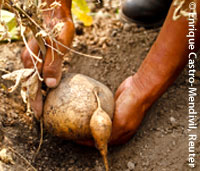Ahipa project
 Ahipa is the name the Inca gave to the highly nutritious legume root produced by the American yam bean. Rich in protein and micronutrients, it shows by far the widest adaptation and highest yield potential among all the storage forming legumes. CIP’s Ahipa Project is a 4-year initiative designed to capture the full food potential of the nutrient-rich American yam bean.
Ahipa is the name the Inca gave to the highly nutritious legume root produced by the American yam bean. Rich in protein and micronutrients, it shows by far the widest adaptation and highest yield potential among all the storage forming legumes. CIP’s Ahipa Project is a 4-year initiative designed to capture the full food potential of the nutrient-rich American yam bean.
The large storage roots, similar in appearance to cassava, are consumed raw, cooked, or processed. Recent research has shown that ahipa roots can be processed into gari: a food product traditionally made from cassava and eaten by millions of people daily in many West African countries. As ahipa has considerably more protein and micronutrient density that cassava, this has highlighted its enormous potential in the marginal, drought-prone cropping systems of Sub-Saharan Africa, where malnutrition is prevalent.
The plant’s seeds contain high oil and protein content , but they are inedible due to the presence of toxins.
CIP’s Ahipa Project works across three continents, with emphasis on West and Central Africa:
- improving availability of ahipa collections and breeding lines
- identifying high yielding varieties adapted to local farming systems
- making ahipa seed usable for human consumption
- developing commercial ahipa products
- implementing marketing strategies
